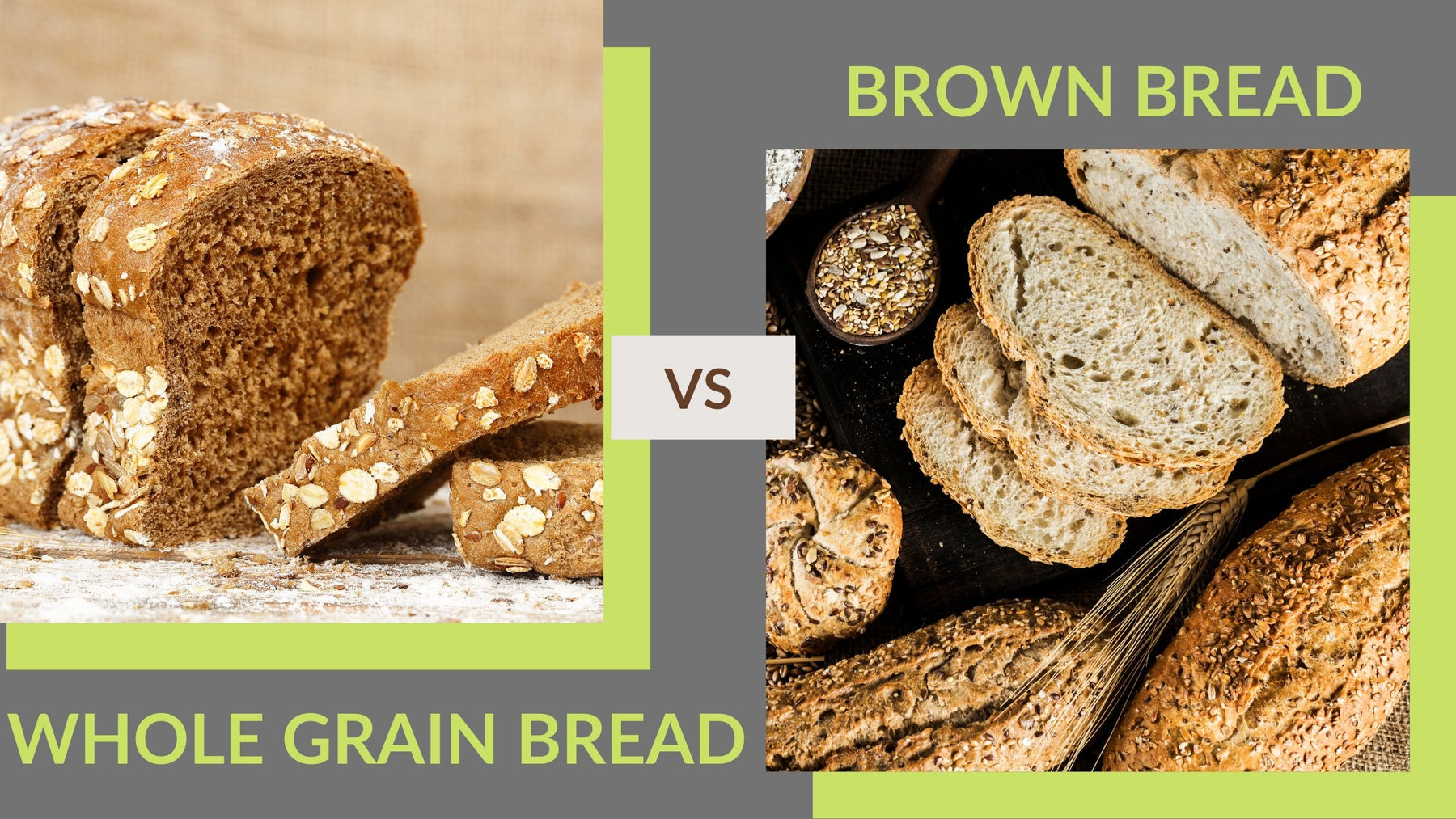
Brown Bread vs Whole Grain Bread
Which one should you pick?
When there is a debate over consuming healthy brown bread, it points primarily to ditching the traditional white bread we have consumed since childhood.
Bread ideally are made from five constituents- flour, yeast, water, oil and salt. But pick up any commercial bread and you will be surprised by the ingredients. Have a look:

The bread available in the market contains tons of sugar or high fructose corn syrup, palm oil, artificial colours, preservatives, acidity regulators, emulsifiers and many more. But, it’s still ‘whole wheat bread’.
Instead of cleaning the unhealthy ingredients in this bread, the marketers blamed it solely on white flour. Hence, the white package bread is an "unhealthy" choice.
The white bread is made of maida, the processed, refined wheat flour that loses most fibre and the nutrients that bind to the fibre.
Most retailers took advantage of this crucial wheat fibre loss aspect and have promoted brown bread as healthy in ads. Many advertisements state the high nutritional values of brown bread and as incredibly healthy! But are the claims valid? Are brown bread healthy, or whole-grain bread is healthy?
What really is brown bread?
The proclaimed healthy brown bread is mostly a sham, and it is mostly nothing but white bread with molasses and caramel colour. You can see through the ingredients to confirm it.
Check the first ingredient on the back of the pack when you buy brown bread. If that is refined wheat flour or "maida", it’s really just white bread. Also if you find the ingredient INS 150 at the end, remember that is the technical name of the brown food colouring.
And then comes the whole wheat bread…
Technically the wheat grain has three parts- the germ, the bran and the endosperm.
However, during the refinement process, the germ and the bran, which contains most of the fibre, lose out, and what remains is just the endosperm. But the whole wheat bread has all three parts intact. And hence, it is more nutritious.
So the whole wheat bread is much healthy?
It is not as simple as it seems.
Once again, look into the ingredients. If the first ingredient in the ‘atta bread’, or whole wheat bread is refined wheat, stay away from it.
The marketers named it whole wheat bread, but how much of it is to be used is not mentioned, so they trick us! So when you purchase whole wheat bread, get the bread 100% whole wheat bread, and check out the ingredients in the back of the pack.
Brown Bread VS Whole Grain Bread
What's the difference between brown bread and whole-grain bread?
A few elements are included in both whole grain bread and brown bread. Whole grains are an essential component of a healthy diet. Brown bread, on the other hand, is typically made using a combination of refined flour and whole wheat flour.
There are also additional additives such as caramel for bringing out the colour of brown bread. Because of deceptive advertising, examining the labels of store-bought bread is essential.
There are significant changes in the preparation of various bread kinds. We know that whole wheat bread is formed from wheat kernels. The kernels include all three major components: bran, germ, and endosperm.
However, the bran and germ are filtered out of many white and wheat loaves. Whole grain bread includes grains like wheat, oats, brown rice, and barley. As a result, whole wheat bread is just one variety of whole-grain bread.
Which bread is the healthiest for you and why?
It makes no difference if the loaves of bread are whole wheat or whole grain as long as it is composed entirely of whole grains. They each have the quality of the ingredients that other forms of bread have lost. Give relative importance to the labelling and packing to determine whether your loaf of bread is 100% whole grain.
Furthermore, if you want to devour the loaf immediately, a freshly baked loaf of whole-grain bread is your best bet. As often as possible, eliminate artificial colours, flavours, and preservatives.
Does whole grain bread help you lose weight?
Consuming whole grain bread as part of a healthy diet is an easy approach. It gives you enough fibre and B vitamins. Whole grains, such as wheat, are high in potassium, manganese, selenium, and other minerals.
Weight loss however, is your overall nutrition and lifestyle changes made. Watch this to understand more:
According to a 2018 study, whole bread intake directly links to fat reduction. This study was published in the journal Plant Foods for Human Nutrition. Study participants who consumed whole-wheat bread reduced visceral fat and body mass index. Others who ate refined wheat bread experienced no alterations.
But quite honestly, this could be due to the healthy benefits of consuming whole grains in general. For instance, brown rice ca also give you the same fat loss benefits.
Is sourdough bread a whole grain?
Sourdough bread would be any bread fermented using yeast and lactobacilli. The lactobacilli is a naturally present bacteria. This organically present bacteria is responsible for the bread's flavour.

The nutritional value of bread is determined by the flour used for its production. As a result, sourdough bread composed entirely of whole grains would be the most nutritional. So pick a whole grain sourdough bread VS a sourdough bread made using white flour.
However, due to the fermenting process, the bread is said to have extra advantages. For instance, it facilitates your body's absorption of minerals. Minerals like magnesium, phosphate, potassium, and zinc that are sometimes hampered by the phytic acid concentration in all other bread. These are sometimes present in sourdough bread in negligible amounts.
Is whole grain bread a complete protein?
An incomplete protein does not include all nine types of amino acids. Complete proteins contain all amino acids required to construct other proteins in your body.
Whole grains are a complete protein source. But because some amino acids might be lower in quantity, supplement your grains with lentils. So adding hummus to your bread or making a tofu sandwich etc.

Experts suggest that people consume a range of proteins regularly. Proteins in the form of lentils, seeds, nuts, and whole grains, to ensure that their diet contains complete proteins.
Can I eat brown bread for weight loss?
Whole grains should be prioritised as an effective weight-loss strategy. Whole grains are higher in vitamins, minerals, and fibre than processed grains. So you want to avoid white bread, but also look out for a brand that is 100% whole wheat.
If you look at the blue zones of the world, where people live the healthiest lives, the consumptions of whole grains averages at 2-3 servings per day. IF you have heard that grains are not good for you, read this for a more scientific accuracy:
Many whole-grain loaves of bread are darker than white bread. However, food makers sometimes use molasses and food colouring to darken refined bread products. Always read the ingredient list.
Is brown bread healthier than white bread?
Brown loaves created from whole wheat retain the seeds outermost coating intact. Brown bread is thus healthier and fiber-rich than white bread. White bread is also higher in calories than brown bread. However, the calorie count difference is not significant.
When it comes to nutrition, brown bread outperforms white bread. Beware though, not all brown bread on the streets is nutritious. Producers occasionally add colour to white bread to make it seem brown. Even the multi-grain bread you choose from the healthy section might not truly be healthy.
Let's Just Talk. No Obligations.
I do free consultations every Tuesday's and Thursday's. Either way you will get some actionable tips to reach your fitness goals faster.


Leave a comment